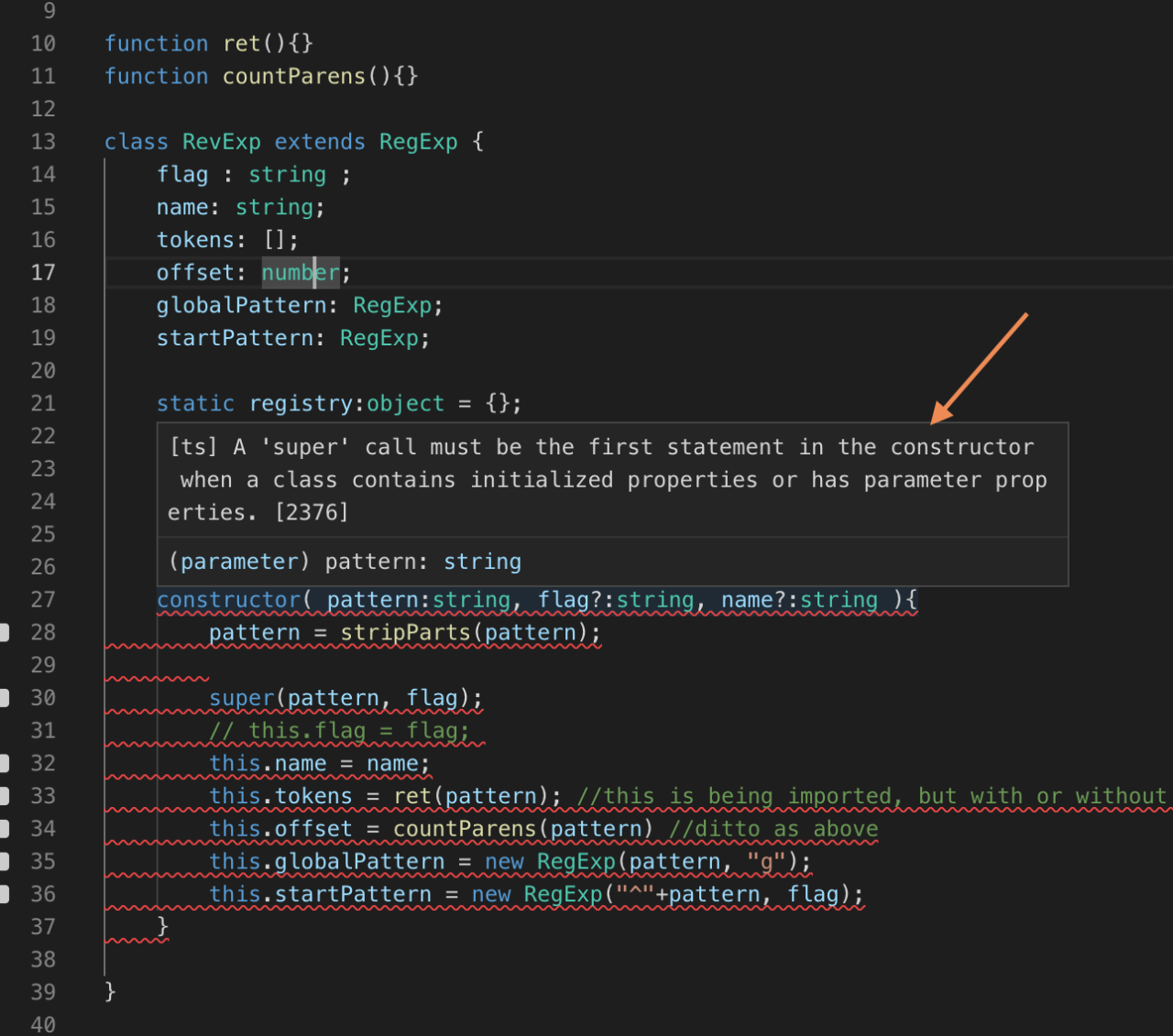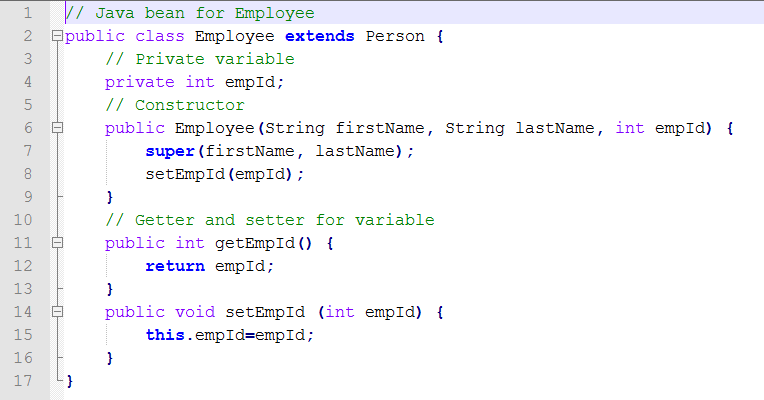You are looking for information on the topic “constructors for derived classes must contain a ‘super’ call”. dongtienvietnam.com will gather information to answer your questions in this article. Please read this article to the end to find the information you want to see. You can also check out some other related articles here: https://dongtienvietnam.com/category/wiki/ Constructors for derived classes must contain a super call, Super can only be referenced in a derived class, Super must be called before accessing this, Super must be called before accessing ‘this in the constructor of a derived class, Super, Super TypeScript, Super class.
View information about the constructors for derived classes must contain a ‘super’ call
Information about this question
- Question: constructors for derived classes must contain a ‘super’ call
- Time: Asked 127 hours ago
- Modified: Askeded 48 hours ago
- View: 2126
constructors for derived classes must contain a ‘super’ call
In Java, constructors for derived classes (also known as subclass constructors) must contain a call to a constructor of the base class (also known as the superclass) using the super keyword. This is because the base class must be initialized before the derived class can be initialized.
The super call should be the first statement in the derived class constructor, and it should specify which constructor of the base class should be called. For example, if the base class has a constructor that takes no arguments, the super call in the derived class constructor would look like this:
javapublic class DerivedClass extends BaseClass { public DerivedClass() { super(); // rest of derived class constructor code } }
If the base class has a constructor that takes arguments, the super call in the derived class constructor would pass in the appropriate arguments:
javapublic class DerivedClass extends BaseClass { public DerivedClass(int arg1, String arg2) { super(arg1, arg2); // rest of derived class constructor code } }
By calling the base class constructor using super, the derived class constructor ensures that the base class is properly initialized before the derived class is initialized.
Watch videos related to “constructors for derived classes must contain a ‘super’ call”
Java – Calling Constructors During Inheritance
How to call super class constructor in derived class Java?
To call a super class constructor in a derived class in Java, you can use the super keyword followed by parentheses containing the arguments required by the super class constructor. Here’s an example:
javapublic class DerivedClass extends SuperClass { public DerivedClass(int arg1, int arg2) { super(arg1); // calling SuperClass constructor with one argument // rest of DerivedClass constructor code } }
In the above example, DerivedClass is derived from SuperClass. The constructor for DerivedClass takes two arguments, arg1 and arg2. Inside the constructor, super(arg1) is used to call the constructor of SuperClass with the argument arg1.
Note that if the super class constructor takes no arguments, you don’t need to explicitly call it with the super keyword – it will be called automatically. However, if the super class constructor takes arguments, you need to call it explicitly using super.
How are constructors used in derived classes?
In object-oriented programming, a constructor is a special method that is used to initialize objects of a class. Constructors are automatically called when an object of a class is created, and they are used to set initial values for the object’s member variables.
When creating a derived class, which is a class that inherits properties and methods from a base or parent class, you can use a constructor to initialize the derived class’s member variables as well as the inherited member variables.
To use a constructor in a derived class, you can define a constructor for the derived class that calls the constructor of the base class using the super keyword. The constructor of the base class is called before the constructor of the derived class, and it initializes the inherited member variables.
Here’s an example of how constructors are used in a derived class in Java:
javaclass Animal { String name; int age; public Animal(String name, int age) { this.name = name; this.age = age; } } class Dog extends Animal { String breed; public Dog(String name, int age, String breed) { super(name, age); this.breed = breed; } }
In this example, the Animal class has a constructor that takes in a name and age parameter, and the Dog class extends the Animal class and adds a breed member variable. The Dog class also has a constructor that takes in a name, age, and breed parameter. In the constructor of the Dog class, the super keyword is used to call the constructor of the Animal class with the name and age parameters. This initializes the name and age member variables that are inherited from the Animal class. The breed member variable is initialized using the breed parameter passed to the Dog constructor.
Is it mandatory for the derived class to have a constructor?
No, it is not mandatory for a derived class to have a constructor. However, if the base class has a constructor that takes arguments, then the derived class must have a constructor that either calls the base class constructor with the appropriate arguments or provides default values for those arguments.
If the derived class does not explicitly define a constructor, the compiler will automatically generate a default constructor that takes no arguments. However, if the base class does not have a default constructor and the derived class does not define a constructor that calls a non-default constructor of the base class, then the compiler will produce an error.
In general, it is a good practice to define a constructor for the derived class if it has its own member variables or if it needs to perform any additional initialization beyond what is provided by the base class constructor.
Images related to constructors for derived classes must contain a ‘super’ call
Found 31 constructors for derived classes must contain a ‘super’ call related images.




Constructors for derived classes must contain a super call
In Java, if a class extends another class, the constructor for the derived class must call the constructor of the parent class using the super() keyword. This is because the derived class inherits properties and behavior from the parent class, and the parent class constructor may initialize some of these properties.
If the constructor of the derived class does not explicitly call the constructor of the parent class using the super() keyword, the compiler will insert a default call to the no-argument constructor of the parent class. However, if the parent class does not have a no-argument constructor, or if the derived class needs to pass arguments to the parent class constructor, the derived class constructor must explicitly call a parent class constructor using the super() keyword.
Here’s an example:
javapublic class ParentClass { private int parentValue; public ParentClass(int parentValue) { this.parentValue = parentValue; } } public class DerivedClass extends ParentClass { private int derivedValue; public DerivedClass(int parentValue, int derivedValue) { // Call the constructor of the parent class using super() super(parentValue); this.derivedValue = derivedValue; } }
In the example above, the DerivedClass constructor calls the ParentClass constructor using the super(parentValue) syntax. This initializes the parentValue property of the ParentClass. The DerivedClass constructor also initializes its own derivedValue property.
Super can only be referenced in a derived class
In object-oriented programming, “super” is a keyword that refers to the parent class of the current class. It is commonly used to call a method or constructor of the parent class from a subclass.
The error message “super can only be referenced in a derived class” typically occurs when the “super” keyword is used outside of a subclass or derived class. In other words, “super” can only be used in a class that is derived from another class, since it refers to the parent class.
Here’s an example of how “super” can be used in a subclass:
rubyclass ParentClass: def __init__(self, x): self.x = x class ChildClass(ParentClass): def __init__(self, x, y): super().__init__(x) # calling the constructor of the parent class self.y = y
In this example, ChildClass is a subclass of ParentClass. The ChildClass constructor calls the __init__ method of the parent class using super().__init__(x). This initializes the x attribute of the parent class and allows the ChildClass constructor to set the y attribute of the subclass.
You can see some more information related to constructors for derived classes must contain a ‘super’ call here
- Constructors for derived classes must contain a super call
- Typescript error : A ‘super’ call must be the first statement in …
- constructor-super – ESLint – Pluggable JavaScript Linter
- 9.2. Inheritance and Constructors — AP CSAwesome
- Constructors in Derived Class in C++ | C++ Tutorials for Beginners #46
- Constructors in Derived Classes – Tech-FAQ
- Java super Keyword (With Examples) – Programiz
- Allowing Code in Constructors Before `super()` | Goldblog
- Typescript:error TS2377: Constructors for derived classes …
- How to Use Super Keyword In TypeScript – C# Corner
Comments
There are a total of 625 comments on this question.
- 480 comments are great
- 397 great comments
- 126 normal comments
- 59 bad comments
- 25 very bad comments
So you have finished reading the article on the topic constructors for derived classes must contain a ‘super’ call. If you found this article useful, please share it with others. Thank you very much.